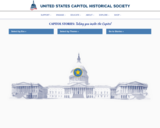
Capitol stories: taking you inside the capitol! Choose by historical era, themes, or specific stories.
- Subject:
- History
- U.S. History
- Material Type:
- Interactive
- Provider:
- United States Capitol Historical Society
- Date Added:
- 11/20/2020

Capitol stories: taking you inside the capitol! Choose by historical era, themes, or specific stories.
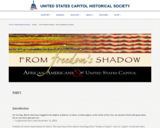
Freedom for some meant slavery for others. The cruel irony of this nation’s founding and its “Temple of Liberty”—the U.S. Capitol—is that both were made possible by the enslavement of African Americans.
The labor of enslaved and free blacks helped build the Capitol. An enslaved African American man helped to cast the Statue of Freedom, which was placed atop the Dome during the Civil War.
Since the end of the Civil War, African Americans have struggled to move out of the shadows and into the Temple of Liberty as full participants.
This the online version of a traveling exhibit by the U.S. Capitol Historical Society that depicts the journey of African Americans from slavery to freedom and political representation in the U.S. Capitol. The exhibit opened February 2006 in Baltimore, Maryland at the Reginald F. Lewis Museum of Maryland African American History and Culture.
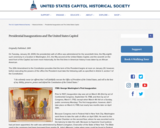
On Tuesday, January 20, 2009, the presidential oath of office was administered for the seventieth time, the fifty-eighth such ceremony in a location in Washington, D.C, the fifty-second at the United States Capitol, and the seventh on the west front of the Capitol; but even more historically, for the first time in American history it was taken by an African American.

The first ten amendments to the U.S. Constitution are known as our Bill of Rights, which serve as a guarantee for our freedoms. But these amendments almost didn’t happen. Join a group of middle schoolers on a tour of Washington, D.C. as they learn about the Constitution and what it means to be “We the People.” The “We the People” videos are produced in collaboration with the U.S. Capitol Historical Society.

Once a vision for the United States of America, crafted by our founding fathers, the Declaration of Independence is preserved as living proof of our history at the National Archives and Records Administration. Join a group of middle schoolers on a tour of Washington, D.C. as they learn about this document and others and what it means to be “We the People.” The “We the People” videos are produced in collaboration with the U.S. Capitol Historical Society.
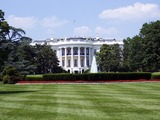
The president of the United States serves as the chief executive and commander of the armed forces, all defined in Article II of the Constitution as the executive branch. Join a group of middle schoolers on a tour of Washington, D.C. as they learn about the Constitution and what it means to be "We the People." The "We the People" videos are produced in collaboration with the U.S. Capitol Historical Society.
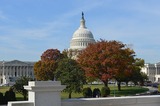
Of the three branches of our government, many believe that the most important is the one directly elected by "We the People": the legislative branch, represented by the two houses of the U.S. Congress at the Capitol building. Join a group of middle schoolers on a tour of Washington, D.C. as they learn about the Constitution and what it means to be "We the People." The "We the People" videos are produced in collaboration with the U.S. Capitol Historical Society.